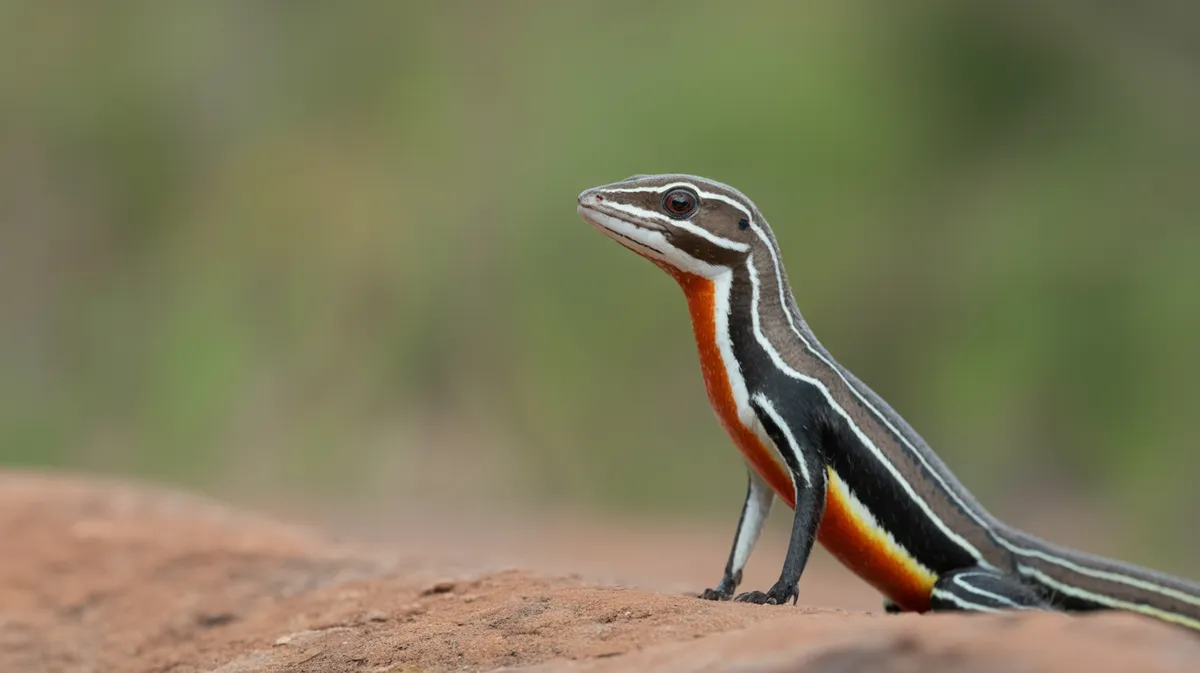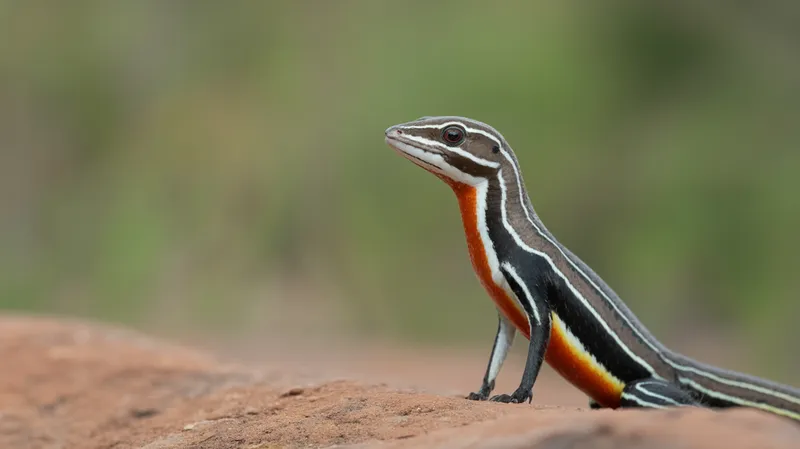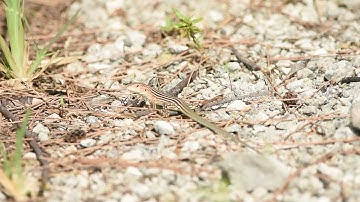
Rainbow Whiptail
Cnemidophorus lemniscatus

Meet the Rainbow Whiptail
The Rainbow Whiptail is a slender, fast-moving lizard known for its strikingly colorful, iridescent scales, which often display green, blue, and yellow hues along its body. Native to Central and South America, this agile reptile is typically found in a variety of open habitats, including savannas, grasslands, and disturbed forests. It is diurnal and highly active, often seen basking in the sun or darting quickly through leaf litter in search of prey. The Rainbow Whiptail is notable for its adaptability and can even thrive in urban environments.
Classification
Reptile
Habitat
Savannas, grasslands, and open forests
Diet
Insectivore
Lifespan
4-8 years
Conservation
Least Concern
Weight
8-15 grams
📖Fascinating Facts
Colorful Appearance
The Rainbow Whiptail gets its name from its shimmering, multicolored scales that can reflect hues of green, blue, and yellow.
Speedy Sprinters
These lizards are incredibly fast and agile, often evading predators by quickly darting into thick vegetation or under rocks.
Tail Regeneration
If threatened, the Rainbow Whiptail can shed its tail to distract predators and later regrow it, though the new tail may differ in appearance.
📋Detailed Description
The Rainbow Whiptail (Cnemidophorus lemniscatus) is a medium-sized, slender lizard, typically reaching a snout-to-vent length of 8–10 cm, with a total length including the tail of up to 30.5 cm (12 inches). Its body is characterized by smooth, shiny scales and a long, whip-like tail that can comprise more than two-thirds of its total length. The coloration is highly variable but often features vivid green, blue, and yellow stripes or spots along the dorsum, with males generally displaying more intense hues. The ventral surface is usually pale, sometimes with a bluish tint. Limbs are well-developed, facilitating rapid terrestrial locomotion, and the digits are elongated with sharp claws for digging and climbing. The head is wedge-shaped with large eyes and a pointed snout, adaptations for visual hunting. Sexual dimorphism is present, with males being slightly larger and more brightly colored than females. Juveniles often exhibit more pronounced striping, which may fade with age. The species is diurnal and highly active, relying on speed and agility to evade predators and capture prey. Its skin is delicate and easily autotomized, allowing the lizard to shed its tail as a defense mechanism.
💡 Did you know?
The Rainbow Whiptail can drop its tail as a defense mechanism to escape predators, and the tail will later regenerate.
🔬Research & Sources
Wikipedia Summary
The rainbow whiptail is a species of lizard found in Central America, the Caribbean, and northern South America. It has also been introduced in Florida and has established populations there. A rainbow whiptail grows up to approximately 12 inches (30.5 cm).
Last Modified: 2/19/2025
🎭Behavior & Social Structure
Rainbow Whiptails are primarily solitary and territorial, with individuals maintaining overlapping home ranges but rarely interacting outside of the breeding season. They are active during the day, especially in the morning and late afternoon when temperatures are optimal. Their foraging behavior is characterized by rapid, jerky movements interspersed with pauses to scan for prey, which includes insects, spiders, and other small invertebrates. They use visual cues to detect movement and employ a sit-and-wait or active search strategy depending on prey availability. When threatened, they rely on their speed and the ability to shed their tail (caudal autotomy) to escape predators. Basking is a common behavior, as thermoregulation is essential for their metabolic processes. Social interactions are limited, but males may display aggressive postures or engage in ritualized combat during the breeding season.
👶Reproduction & Life Cycle
Cnemidophorus lemniscatus exhibits both sexual and parthenogenetic reproduction, with some populations consisting entirely of females capable of producing viable offspring without fertilization. Sexual populations breed seasonally, typically during the rainy season when food is abundant. Courtship involves visual displays and tactile stimulation by the male. Females lay 1–5 elongated, leathery eggs per clutch, often in concealed, moist locations such as under logs or in loose soil. Incubation lasts 60–75 days, depending on temperature and humidity. There is no parental care; hatchlings are independent from birth and resemble miniature adults. Parthenogenetic populations, which are especially common on Caribbean islands, can reproduce more rapidly and colonize new habitats efficiently.
🛡️Adaptations & Survival
The Rainbow Whiptail's elongated limbs and tail provide exceptional speed and maneuverability, aiding in both predator evasion and prey capture. Its keen vision is adapted for detecting small, fast-moving invertebrates. The ability to autotomize the tail is a critical anti-predator adaptation, as the detached tail continues to wriggle and distract predators while the lizard escapes. Parthenogenesis in some populations is a remarkable evolutionary adaptation, allowing rapid population growth and colonization of new or isolated environments. The species' tolerance for disturbed habitats and urban areas demonstrates ecological plasticity, while its cryptic coloration provides camouflage among leaf litter and grasses.
📚Research Sources
🎨Cultural Significance
While not a major figure in indigenous mythology or folklore, the Rainbow Whiptail is sometimes appreciated for its vibrant coloration and energetic behavior. In some regions, it is considered a beneficial species due to its role in controlling insect populations. It is occasionally kept as a pet, though not commonly in the international pet trade. Its presence in urban gardens and parks has made it a familiar sight in parts of its introduced and native range.
🔬Recent Research & Discoveries
Recent research has focused on the genetic mechanisms underlying parthenogenesis in Cnemidophorus lemniscatus, providing insights into vertebrate asexual reproduction and hybridization events. Studies have also examined the ecological impacts of introduced populations in Florida, where the species has established stable, self-sustaining colonies. Ongoing work investigates the species' adaptability to urban environments, physiological responses to temperature variation, and the role of color polymorphism in mate selection and predator avoidance. The Rainbow Whiptail serves as a model organism for studying evolutionary biology, reproductive ecology, and the effects of habitat fragmentation.
🎥Wildlife Videos

Flying Rainbow - An Epic Tale of Survival | Free Documentary Nature
Flying Rainbow - An Epic Tale of Survival | Wildlife Documentary Watch 'Kingfisher - The Hunt for Germany's Flying Diamond' ...
Free Documentary - Nature

Tiger red panda rainbow whiptail crocodile lizard magnificent tree frog stork Cape twig snake 13484
Download and listen to my new MUSIC and BOOKS on Spotify, iTunes, Amazon, many stores, many platforms etc. Share and ...
Serban Cioca

Rainbow Whiptail (Cnemidophorus lemniscatus) waving in Miami, Fl
Originally misidentified as a six-lined racerunner (Aspidoscelis sexlineatus)... First time I see this behavior. There were many of ...
Joe MDO

Wildlife Instincts: Chameleons - Designed to Hunt | Free Documentary Nature
Wildlife Instincts - Episode 4: Chameleons - Designed to Hunt | Free Documentary Nature Watch "Wildlife Instincts: A Family Bond ...
Free Documentary - Nature

30 Most Beautiful Creatures On Earth (Order Galliformes) | Wildlife Documentary | BBTV Official
In the heart of the world's most remote forests and rugged highlands, where mist lingers over ancient trees and the wilderness ...
BBTV Official

Rainbow Whiptail, Cnemidophorus lemniscatus, Wenkpootje, Peperpot, Suriname, 27 Nov 2017
This I think is an immature individual, because of the longitudinal lines over the back. The Dutch/Suriname name, "Wenkpootje", ...
Remco Hofland
🌍Habitat Information
The Rainbow Whiptail typically inhabits Savannas, grasslands, and open forests environments. Rainbow Whiptails have adapted to their environments with specialized features and behaviors.
Primary Habitat:
Savannas, grasslands, and open forests
More detailed habitat information will be available soon.
🛡️Conservation Status
The Rainbow Whiptail is currently classified as Least Concern. Conservation efforts are crucial for preserving this species for future generations.
Common Threats:
- 🏠Habitat loss and fragmentation
- 🌡️Climate change impacts
- 🎯Hunting and poaching
- 🏭Human-wildlife conflict
⚠️Threats & Conservation Challenges
Currently assessed as Least Concern by the IUCN, the Rainbow Whiptail faces localized threats such as habitat loss due to agriculture, urbanization, and deforestation. In some areas, predation by introduced species (e.g., domestic cats, dogs, and mongooses) poses a risk. Pesticide use may reduce prey availability and cause direct toxicity. However, the species' adaptability and reproductive versatility have enabled it to maintain stable populations across much of its range. Climate change could alter habitat suitability and impact reproductive timing, but no significant population declines have been documented.
🔬Scientific Classification
Scientific Name
Cnemidophorus lemniscatus
Classification Hierarchy
🔍 About Taxonomic Classification
Taxonomic classification is a hierarchical system used by scientists to classify and organize living organisms based on shared characteristics and evolutionary relationships.
The system moves from broad categories (Kingdom) to increasingly specific ones, with each animal's scientific name typically consisting of its Genus and species.
📝Community Notes
Share your observations and insights about the Rainbow Whiptail with our community of wildlife enthusiasts.
Join Our Community
Sign in to share your observations and connect with fellow wildlife enthusiasts.
Sign In to ContributeNo community notes yet
Be the first to share your observations about the Rainbow Whiptail!
Explore Rainbow Whiptail
Select a tab above to learn more about this amazing animal.
📸Photo Gallery
No photos available for this animal yet.
🌟Discover More Wildlife
Continue your journey of discovery with more fascinating animals from our database
